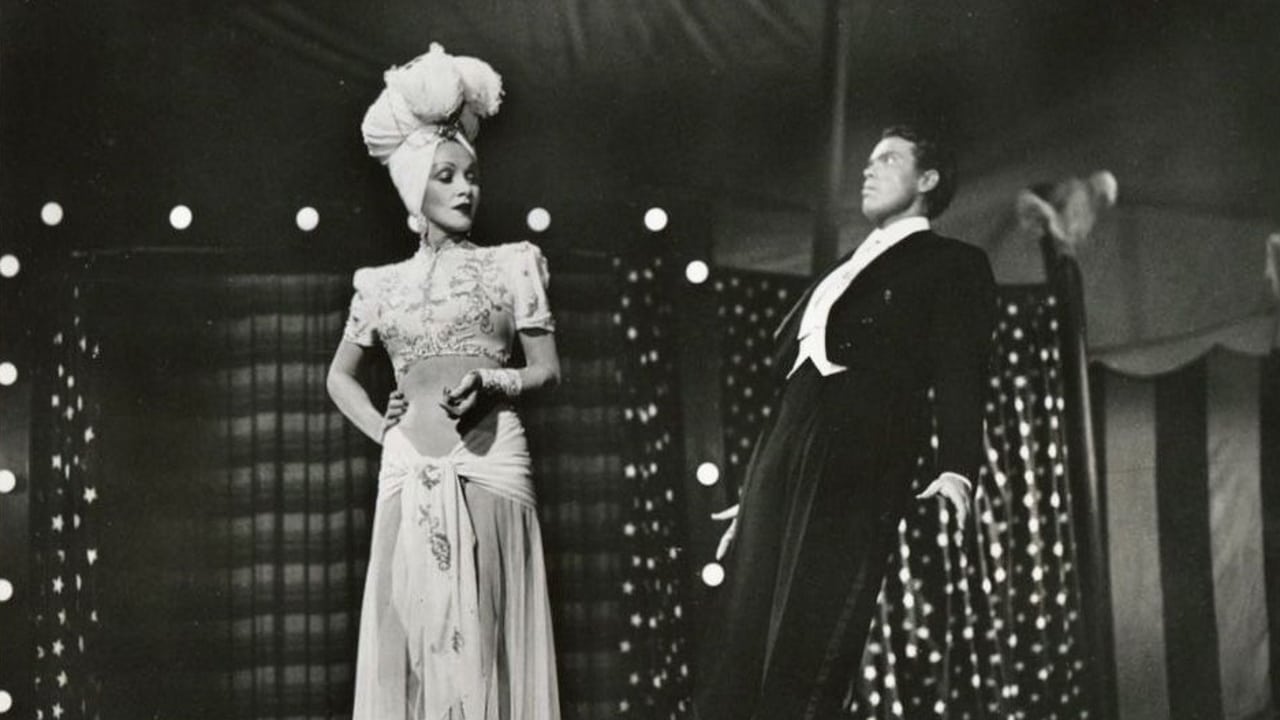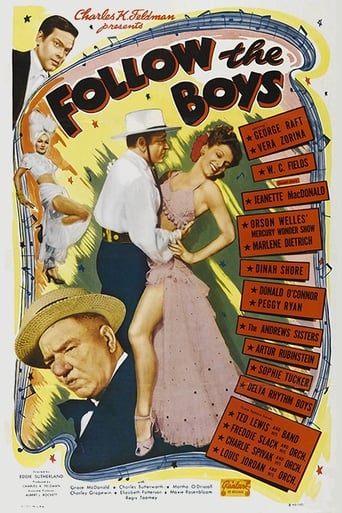

What a waste of my time!!!
... View MoreOne of my all time favorites.
... View MoreMost undeservingly overhyped movie of all time??
... View MoreIt is neither dumb nor smart enough to be fun, and spends way too much time with its boring human characters.
... View More1944's "Follow the Boys" was hardly the first entry in the studios' rush to provide wartime entertainment in the form of a musical revue featuring contract players going all out for victory. Universal didn't have the kind of stars that the majors had, so they resorted to borrowing George Raft and Vera Zorina to kick off the initial storyline, vaudeville hoofers lamenting its demise only to find new life in serving the armed forces by performing on a worldwide scale. W.C. Fields drops by to play out his ancient (circa 1903) pool routine, done earlier in 1915's "Pool Sharks" (his screen debut) and 1934's "Six of a Kind." Jeannette MacDonald reprises her greatest triumph, "Beyond the Blue Horizon," as do The Andrews Sisters (they sing a medley of their hits), while bandleaders Charlie Pivak, Freddie Slack, Ted Lewis ("is everybody happy?"), and Louis Jordan round out the musical portion. There is an amusing dog act that ends in breathless fashion, and Orson Welles indulging in one of his favorite pastimes, prestidigitation, with gorgeous Marlene Dietrich an assistant that any magician would literally die for (being sawed in half just about does it!). Around the half hour mark Raft addresses an assembly of actors making up most of Universal's stable, mostly silent and observing, some granted a line or two - Andy Devine, Lon Chaney, Randolph Scott, Evelyn Ankers, Alan Curtis, Turhan Bey, Nigel Bruce, Lois Collier, Peter Coe, Susanna Foster, Gloria Jean, Thomas Gomez, Elyse Knox, Maria Montez, Robert Paige, and Gale Sondergaard. For Lon Chaney fans, it's enough to see him sitting right behind Sophie Tucker, wearing the same mustache from his just completed "Calling Dr. Death," since a few months earlier he was definitely absent from Olsen and Johnson's "Crazy House" (this was the last time he was unbilled on screen).
... View MoreThen-topical puttin'-on-a-show-for-the-troops film is now interesting, from a historical perspective, for a certain documentary-like quality. Though it was made by Universal, it doesn't shy away from name-dropping other movie studios and performers, as parts of the collective effort of the entertainment industries to give soldiers a few hours of joy during WWII. Worth catching are the historic first teaming of Orson Welels and Marlene Dietrich (he does some magic tricks, and then saws her in half; "we lose a girl in every performance!", he warns the audience), and a lively Donald O'Connor - Peggy Ryan duet. But the main "plot" is a drag: George Raft is miscast, especially in the early scenes that require a light touch (with that voice, he always sounds as if he is about to punch someone), and Vera Zorina, a real-life dancer, is mostly relegated to a thankless dramatic part. Note: I watched the edited, 110-minute version. ** out of 4.
... View MoreThis movie is full of surprises, including an Andrews Sister mimicking a strip tease, a full scale dog act including trapeze tricks, Dinah Shore at the beginning of her long career, George Raft doing a Valentino take-off, Arthur Rubinstein performing on the piano a song that Spike Jones later had a hit with, Charlie Spivak and his orchestra proving that Harry James had no corner on mooing horns and muted muzak, and what appears to be Getty Grable dancing in cold weather issue Micky Mouse boots! Louis Jourdan and his band are the stand-outs among the musical performances, with "Is You Is or Is You Ain't". George Raft doing a soft-shoe in the rain to Jourdan's "Sweet Georgia Brown" is a close second. The big surprise is Orson Welles, relatively svelte, performing some David Copperfield-like magic tricks with a magnificent stage presence. Those who have seen the Peter Seller's and David Niven "Casino Royale" will know what I mean. By the way, "Casino Royale" also included George Raft in a brief cameo.A bit long and interrupted by an unnecessary plot, this flick is worth seeing again and again.
... View MoreThis is a very good movie to see for the entertainers who are really the stars here. Plus you get a real good feel for the organization that went into getting all of the stars to the troops. This is a good look at history from the standpoint of getting to see the stars of the 1940s. Good music too. 7/10
... View More